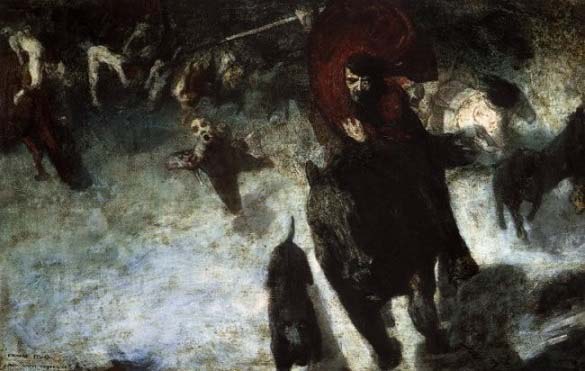Wild Hunt- otherwise called wild hounding or wild raid. It’s a very old and at the same time very common myth, that shows up in every indo-european folk, its idea was changing , depending on geographic area and the historical period of the culture. Wild Hunt was, most commonly, imagined as a procession of ghosts: hunters, soldiers, dogs or horses.
Probably, the most popular and the best known representative of the Wild Hunt is its german-scandinavian version (surely because their myths was preserved much better than the slavic ones for example). It’s believed, that the Odyn’s (Wotan) procession is its prototype, who was taking falling warriors to Walhalla. Later on, it was firmly demonised and has become a Wild Hunt of the goddess Holda, who was Wotan’s wife (also called Hudra, and according to Wladyslaw Kopalinski, in German folklore, demons called holdas were, among others, guides of deads’ souls). In celtic mythology, appears a procession of god Gwynn ap Nudd, whereas in anglo-saxon folklore we can find a hunter, Hern, who’s a ghost of the forest, wearing deer horns and traveling with his procession of elfs (Sidhe), guarding the local wildlife (his prototype is Cernunnos, meaning a Horned God, who’s a husband of the Great Goddess, whereas the Hern’s figure is present, among others, in Shakespear’s works and some legends about Robin Hood). The last two examples clearly show close relationships of this demonic procession with the forces of wildlife and wildness of nature.

Wild Hunt defined Hari characters (later Herilaz), who were the wandering warriors-wolves (giving glory to Wotan). Under the influence of ecstasy, they were joining the herds and ritually raiding the villages, during the period between May 1st and a celtic holiday, Samhain (Halloween), most commonly during the new moon. It is presumed that these raids were supposed to keep the world in harmony, especially when the humanity more often came from the nomadic, hunting and gathering life to agricultural, setteled stage. (Wild Hunt, sometimes, was identified with the unity of nature and wildlife). As he was a personification of the forces of nature and human’s “wild” origin, he was the counterweight for “domesticated”, settled people.

Myth about the Wild Hunt was used by Andrzej Sapkowski in his series about the Witcher (it also appears in games about Geralt of Rivia). Henryk Sienkiewicz also devoted him a few lines in his book “Potop”.
Other book positions, where the story of the Wild Hunt was used, are, among others: “The Wild Hunt” by J.Foxe, “The War Hound and the World’s Pain” by M.Moorcock (the first of the “von Bek” series of novels.), “The Wild Hunt” by J.Yolen

And what about the fate of the person who saw the Wild Hunt on the sky? Depending on a legend, he could be kidnapped or forced, by a hipnotic suggestion, to join the group. Seeing this demonic procession could be also an omen of the coming catastrophy. People kidnapped by the Wild Hunt could experience a considerable dilatation of time and appear on Earth many years (or even centuries) later.
Przeczytaj oryginalny polski artykuł o micie Dziki Gon.
 Słowiański Bestiariusz Kompendium wierzeń, demonologii, symboli i bóstw słowiańskich. Poruszamy również tematy dotyczące medycyny ludowej i życia codziennego Słowian.
Słowiański Bestiariusz Kompendium wierzeń, demonologii, symboli i bóstw słowiańskich. Poruszamy również tematy dotyczące medycyny ludowej i życia codziennego Słowian.
